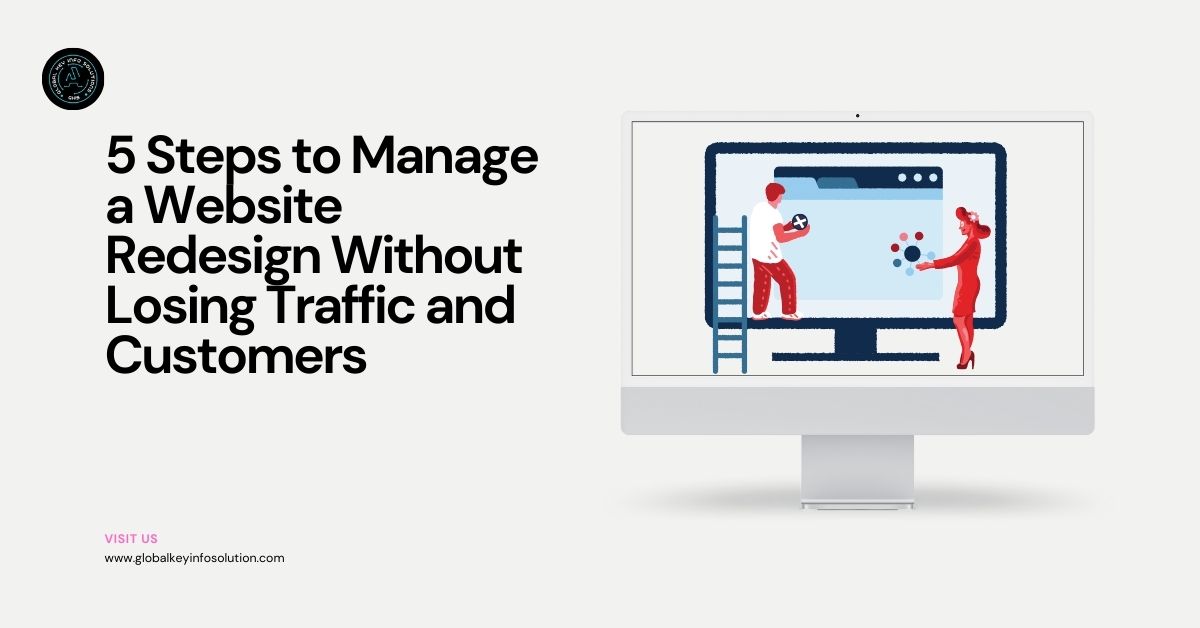
In today’s fast-paced digital landscape, a Website Redesign can be a powerful way to improve your online presence and meet evolving customer expectations. However, if not handled properly, it can disrupt your traffic, affect search rankings, and potentially alienate your loyal audience. The good news? By following a strategic approach, you can redesign your website without losing traffic or customers. Here are five essential steps to guide you through the process.
1. Define Clear Goals for Your Website Redesign
Before diving into the technical aspects, take a step back and define your goals. Why are you redesigning your website? Common reasons include:
- Improving UI/UX design to enhance user experience.
- Making the site mobile-friendly with responsive web design.
- Updating branding or aesthetics.
- Adding new functionalities with full-stack development services.
- Boosting conversion rates or search rankings.
Clearly outlined goals will help you measure the success of the redesign and keep the project focused. For example, if your primary goal is to improve user engagement, prioritize intuitive navigation and visually appealing layouts. On the other hand, if SEO performance is critical, focus on maintaining URL structures and optimizing your content.
2. Conduct a Comprehensive Website Audit
A successful website redesign starts with understanding the strengths and weaknesses of your current site. Conducting a thorough audit helps you identify what works, what doesn’t, and what can be improved. Key areas to evaluate include:
- Analytics: Use tools like Google Analytics to identify high-performing pages, bounce rates, and traffic sources.
- Content Quality: Determine which pages resonate with your audience and which need updates.
- SEO Performance: Check for broken links, outdated meta tags, and poorly optimized keywords.
- Technical Aspects: Evaluate loading speed, security protocols, and mobile responsiveness.
This data will serve as a foundation for making informed decisions during the redesign process, ensuring you don’t lose valuable traffic or functionality.
3. Create a User-Centric Design Plan
User experience is at the heart of any successful website redesign. A well-thought-out UI/UX design ensures that your visitors can easily navigate the site, find the information they need, and take desired actions. Here are some best practices to consider:
- Responsive Web Design: Ensure your site is mobile-friendly and adapts seamlessly to all devices and screen sizes. With mobile traffic continuing to grow, this is non-negotiable.
- Intuitive Navigation: Simplify your menus and categorize content logically to make it easy for users to explore.
- Visual Hierarchy: Use colors, fonts, and imagery strategically to guide users’ attention to important elements.
- Accessibility: Incorporate features like alt text for images and keyboard navigation to ensure inclusivity.
Engaging full-stack development services can help you implement these features effectively, ensuring a seamless and polished end product.
4. Maintain SEO During the Transition
One of the biggest risks of a website redesign is losing your hard-earned SEO rankings. To avoid this, take proactive steps to preserve your search engine visibility:
- URL Structure: Maintain existing URLs whenever possible. If changes are necessary, use 301 redirects to guide search engines and users to the new pages.
- Meta Tags and Keywords: Transfer optimized meta titles, descriptions, and keywords to the new site.
- Content Optimization: Ensure all existing high-performing content is migrated accurately, and update it where necessary.
- Technical SEO: Conduct a pre-launch audit to fix broken links, ensure proper indexing, and validate XML sitemaps.
- Monitor Performance: Use tools like Google Search Console to track traffic, crawl errors, and ranking fluctuations after the launch.
By addressing these factors, you’ll minimize the risk of traffic loss and ensure your audience can easily find your revamped site.
5. Test, Launch, and Continuously Improve
A website redesign doesn’t end at launch. Rigorous testing and post-launch monitoring are crucial to ensure everything functions as expected. Here’s what you need to do:
- Pre-Launch Testing: Test every element of your site, from navigation menus and forms to page load speeds and mobile responsiveness. This is where your full-stack development services team can shine, ensuring a flawless experience.
- Soft Launch: Consider launching the site to a small audience first to gather feedback and identify issues before a full rollout.
- Post-Launch Monitoring: Track user behavior, SEO performance, and technical metrics to detect and resolve any problems quickly.
- Iterative Improvements: Based on user feedback and analytics, continue to refine the design, content, and functionality over time.
A successful redesign is an ongoing process that adapts to changing user needs and industry trends.
Final Thoughts
A website redesign is an exciting opportunity to elevate your online presence and better serve your audience. By setting clear goals, conducting a thorough audit, focusing on responsive web design and UI/UX design, safeguarding your SEO, and committing to continuous improvement, you can navigate the process without losing traffic or customers.
Partnering with experts in full-stack development services can also make a significant difference, ensuring a smooth transition and a stunning end result. So take the plunge, and give your website the refresh it deserves while keeping your audience engaged and your business thriving.











